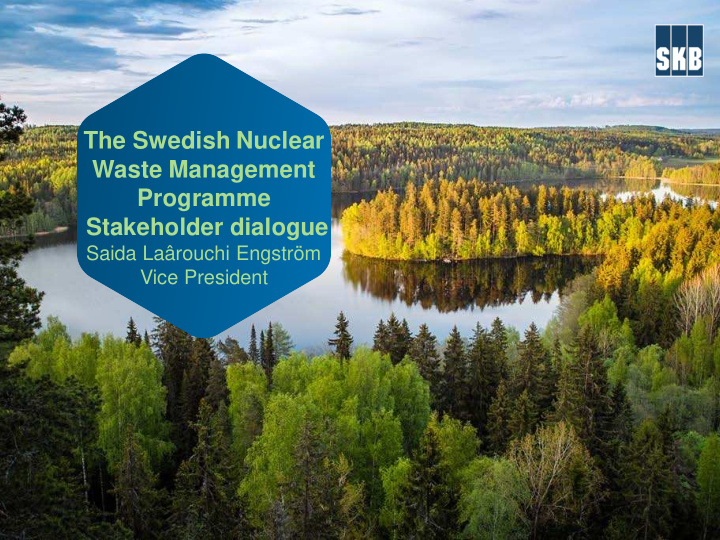



The Swedish Nuclear Waste Management Programme Stakeholder dialogue Saida Laârouchi Engström Vice President
Sweden • 10 reactors at 3 sites (after June 1st 2005) • ~50% electricity • 12,000 tonnes of spent fuel SVENSK KÄRNBRÄNSLEHANTERING
Clear roles, responsibilities and financing of great importance The Swedish Radioactive Waste Management Programme • The nuclear power industry is responsible for taking care of its own waste. • The Swedish Nuclear Fuel and Waste Management Co (SKB) was founded, and is owned by, reactor owners to fulfil the mission. • Financing secured through The Nuclear Waste Fund. • Control and review from society (Government, regulator, authorities and municipalities). • Participation and influence for other stakeholders. SVENSK KÄRNBRÄNSLEHANTERING 2016-03-21 3
SKB’s system Final repository for spent Medical care, industry and research Final repository for short-lived nuclear fuel in Forsmark radioactive waste SVENSK KÄRNBRÄNSLEHANTERING
Research, technology and review Research cooperation Technology development and full scale tests Regularly review SVENSK KÄRNBRÄNSLEHANTERING
SKB’s method SVENSK KÄRNBRÄNSLEHANTERING
Framing the challenge! • Nuclear waste exists and needs to be taken care of - regardless of what we think about future of nuclear power. • There is a technology and a system to take care of all nuclear waste in Sweden today in a safe way. • In order to protect the environment and humans in the long term, SKB intends to build a deep geological repository for spent nuclear fuel. • Safety and transparency are the prerequisites to our mission. SVENSK KÄRNBRÄNSLEHANTERING
Research and technology Selection of a site SVENSK KÄRNBRÄNSLEHANTERING
Consent based site selection? • Consent to what? • With whom? • For how long? • How does the commitment look like? Which administrative and political levels should be involved? • Better answer all these questions before you start your dialog! SVENSK KÄRNBRÄNSLEHANTERING
The journey in view of a selected site SVENSK KÄRNBRÄNSLEHANTERING
Aspects that complicate the site selection process for a nuclear installation • North – South • City – Countryside • Establishment – Individual • Facts – Emotions • Women – Men • POLITICS! SVENSK KÄRNBRÄNSLEHANTERING
Finding a site is also learning to know your hosting community! Building a repository Type areas Regional studies Feasibility studies Site investigations 1977–1985 1990s Trial operation 2030 1993–2002 2002–2008 SVENSK KÄRNBRÄNSLEHANTERING
Clink and Spent fuel repository Two parallel licensing processes – SKB needs five approvals SVENSK KÄRNBRÄNSLEHANTERING
SKB has selected Forsmark • The rock in Forsmark offers much better prerequisites for long-term, safe disposal and facilitates implementation. • The rock is homogenous and only has sparsely fractured water-carrying rock at repository depth. • Good thermal conductivity allows the repository to take up less space. • Less rock mass and material for backfill. • Buildings above ground can be built within the existing industrial area. • Access to infrastructure. • Limits impact on the environment. SVENSK KÄRNBRÄNSLEHANTERING
Consultations with various stakeholders National/international Local/regional Municipality, county Authorities administrative board Swedish Radiation Safety Authority The Swedish EPA, etc. Members of the public Baltic sea countries Particularly affected (The Espoo Convention) members of the public NGOs NGOs Nature and environmental Nature and environmental conservation organisations, etc. conservation organisations, etc. SVENSK KÄRNBRÄNSLEHANTERING
Fundamentals in the site selection process • Transparent process based on voluntary participation and respect for local democracy. • Step-wise implementation. • Constant dialogue, knowledge building and stakeholder involvement. • Clear role division between state and industry. • Ability and political will, on national as well as on local level, to go forward and make necessary decisions. • Intergenerational equity. SVENSK KÄRNBRÄNSLEHANTERING
Lessons learned • Focus your project and define the challenge properly • Empower your candidate communities • Be authentic and use your best experts not PR- people • Be prepared to have your project questioned • Carry out your dialogue on the receiver’s terms and pace • Prioritise individuals and small groups • Respect other opinions, anxieties and fears • Demand respect in return • Encourage knowledge-sharing as a value in itself even with your opponents • Be patient and acquire good endurance SVENSK KÄRNBRÄNSLEHANTERING
Recommend
More recommend